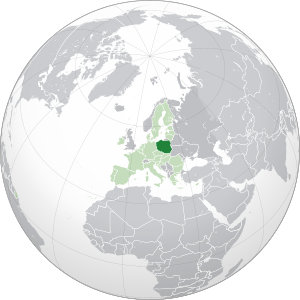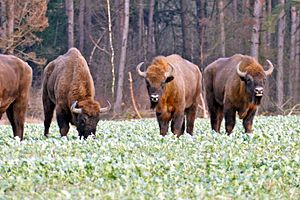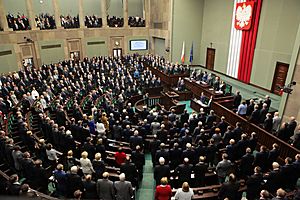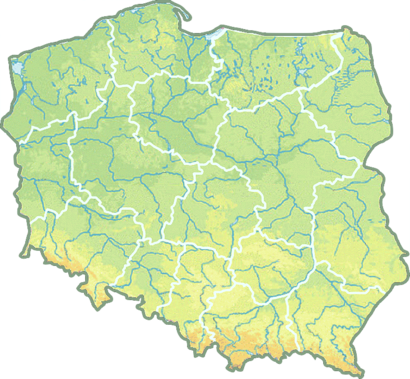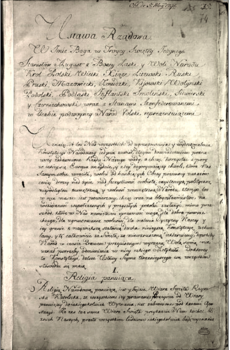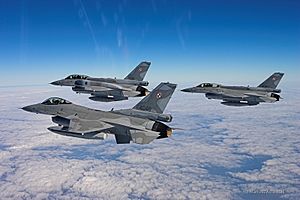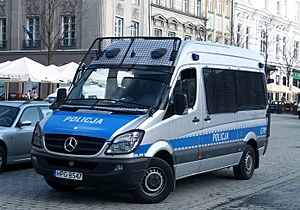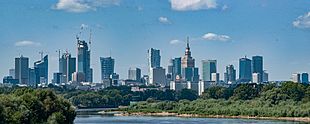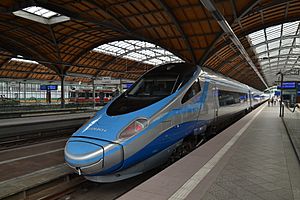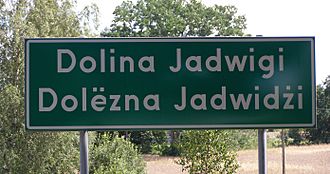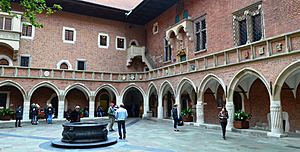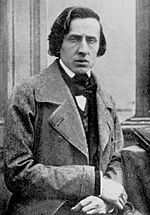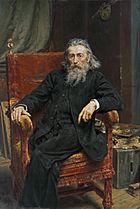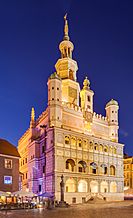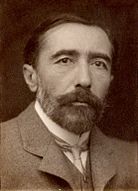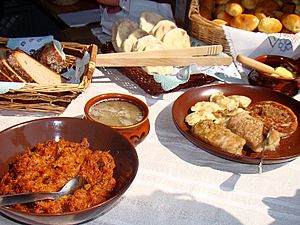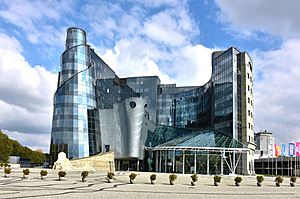Poland facts for kids
Quick facts for kids
Republic of Poland
Rzeczpospolita Polska (Polish)
|
|
|---|---|
|
Anthem: "Mazurek Dąbrowskiego"
Poland Is Not Yet Lost |
|
|
Location of Poland (dark green)
– on the European continent (green & dark grey) |
|
| Capital and largest city
|
Warsaw 52°13′N 21°02′E / 52.217°N 21.033°E |
| Official language | Polish |
| Ethnic groups
(2021)
|
|
| Religion
(2021)
|
|
| Demonym(s) |
|
| Government | Unitary semi-presidential republic |
| Karol Nawrocki | |
| Donald Tusk | |
| Legislature | Parliament |
| Senate | |
| Sejm | |
| Formation | |
|
• Baptism of Poland
|
14 April 966 |
|
• Kingdom of Poland
|
18 April 1025 |
| 1 July 1569 | |
| 11 November 1918 | |
| 17 September 1939 | |
| 19 February 1947 | |
| 31 December 1989 | |
| Area | |
|
• Total
|
312,696 km2 (120,733 sq mi) (69th) |
|
• Water (%)
|
1.48 (2015) |
| Population | |
|
• 2022 census
|
|
|
• Density
|
126/km2 (326.3/sq mi) (75th) |
| GDP (PPP) | 2025 estimate |
|
• Total
|
|
|
• Per capita
|
|
| GDP (nominal) | 2025 estimate |
|
• Total
|
|
|
• Per capita
|
|
| Gini (2022) | ▼ 26.3 low |
| HDI (2023) | very high · 35th |
| Currency | Złoty (PLN) |
| Time zone | UTC+1 (CET) |
|
• Summer (DST)
|
UTC+2 (CEST) |
| Date format | dd.mm.yyyy (CE) |
| Driving side | right |
| Calling code | +48 |
| ISO 3166 code | PL |
| Internet TLD | .pl |
|
|
Poland, officially known as the Republic of Poland, is a country located in Central Europe. It is divided into 16 regions called voivodeships. Poland covers an area of about 312,696 square kilometers (120,732 sq mi).
With a population of 38 million people, Poland is the fifth-most populated country in the European Union. Warsaw is the capital city and also the largest metropolis. Other important cities include Kraków, Wrocław, Łódź, Poznań, Gdańsk, and Szczecin.
Poland has a temperate climate that changes across the country. Its land stretches across the Central European Plain. In the north, it reaches the Baltic Sea, and in the south, it touches the Sudeten and Carpathian Mountains. The longest river in Poland is the Vistula. The highest point is Mount Rysy, found in the Tatra mountain range.
Poland shares borders with Lithuania and Russia to the northeast. To the east, it borders Belarus and Ukraine. Slovakia and the Czech Republic are to the south, and Germany is to the west. Poland also has sea borders with Denmark and Sweden.
Contents
Poland's Rich History
People have lived in Poland since the Lower Paleolithic period. This means humans were there a very long time ago! The region became home to the West Slavic tribes called Polans in the early medieval period. These tribes gave Poland its name.
Poland became a state when its pagan ruler, Mieszko I, became a Christian in 966. This happened with the help of the Roman Catholic Church. The Kingdom of Poland started in 1025. In 1569, it joined with Lithuania to form the Polish–Lithuanian Commonwealth.
At that time, the Commonwealth was one of the most powerful countries in Europe. It had a unique political system where kings were elected. It also adopted Europe's first modern constitution in 1791.
After a successful period, Poland was divided by its neighbors in the late 1700s. Poland became independent again after World War I in 1918. This led to the creation of the Second Polish Republic. This new republic won many battles between the two World Wars.
In September 1939, Germany and the Soviet Union invaded Poland. This started World War II. Millions of Polish people died, and the Holocaust happened. After the war, Poland became part of the Eastern Bloc during the Cold War. It was called the Polish People's Republic.
The Solidarity movement helped end the communist government. Poland became a democratic country again in 1989. It was the first country in its region to do so.
In 2007, Poland joined the Schengen Area. This meant its borders with other European Union countries were removed. People can now travel freely within most of the European Union.
Exploring Poland's Geography

Poland is the ninth-largest country in Europe. It covers about 312,722 square kilometers (120,742 sq mi). Most of this area is land. The rest is made up of internal waters and sea territory.
Poland's landscape has many different landforms, water bodies, and ecosystems. The central and northern parts, near the Baltic Sea, are flat. This area is part of the Central European Plain. The southern part is hilly and mountainous. The average height above sea level is 173 meters (568 feet).
The country has a coastline of about 770 kilometers (478 miles) along the Baltic Sea. The coast has many sand dunes and lagoons. Famous examples include the Hel Peninsula and the Vistula Lagoon. The largest Polish island in the Baltic Sea is Wolin. It is located within Wolin National Park.
Mountains and Rivers
The southern part of Poland has two main mountain ranges. These are the Sudetes in the west and the Carpathians in the east. The highest part of the Carpathians is the Tatra Mountains. They run along Poland's southern border.
Poland's highest point is Mount Rysy, which is 2,501 meters (8,205 feet) high. It is located in the Tatras. The highest peak in the Sudetes is Mount Śnieżka, at 1,603.3 meters (5,260 feet). The lowest point in Poland is at Raczki Elbląskie, which is 1.8 meters (5.9 feet) below sea level.
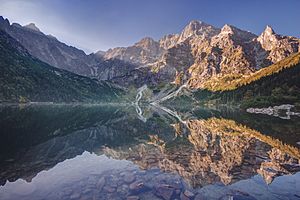
Poland's longest rivers are the Vistula, the Oder, the Warta, and the Bug. The country also has many lakes, about ten thousand of them. Most are in the northeastern region of Masuria, in the Masurian Lake District. The largest lakes are Śniardwy and Mamry. The deepest lake is Lake Hańcza, which is 108.5 meters (356 feet) deep.
Poland's Climate
Poland has a temperate climate that changes from oceanic in the northwest to continental in the southeast. The mountainous southern areas have an alpine climate. Summers are warm, with an average temperature of about 20°C (68°F) in July. Winters are moderately cold, averaging -1°C (30°F) in December.
The warmest and sunniest part of Poland is Lower Silesia in the southwest. The coldest region is the northeast, around Suwałki. This area is affected by cold fronts from Scandinavia and Siberia. Rainfall is more common in summer, with the most rain from June to September.
Weather can change a lot from day to day. The start of each season can also be different every year. Climate change has caused temperatures to rise. Winters are becoming drier, with less sleet and snowfall.
Poland's Biodiversity: Plants and Animals
Poland is home to many different plants and animals. Forests cover 31% of Poland's land. The largest forest is the Lower Silesian Wilderness. Common deciduous trees include oak, maple, and beech. Common conifer trees are pine, spruce, and fir. About 69% of all forests are coniferous.
Poland's flora (plants) and fauna (animals) are typical for Continental Europe. The wisent (European bison), white stork, and white-tailed eagle are national animals. The red common poppy is the unofficial flower symbol.
Protected animals include the European bison, which is Europe's heaviest land animal. Also protected are the Eurasian beaver, the lynx, the gray wolf, and the Tatra chamois. Game animals like red deer, roe deer, and wild boar live in most woodlands. Poland is also an important place for migratory birds. About one-quarter of the world's white storks breed here.
About 1% of Poland's land is protected within 23 national parks. Two of these, Białowieża and Bieszczady, are UNESCO World Heritage Sites. There are also many landscape parks and nature reserves.
How Poland is Governed
Poland is a unitary parliamentary republic and a representative democracy. This means people elect representatives to make decisions. The president is the head of state. The Council of Ministers and the prime minister (who is the head of government) also hold executive power. The prime minister chooses the council members, who are then approved by the president and parliament. The president is elected by popular vote for a five-year term.
Poland's legislative body is a two-house parliament. It has a 460-member lower house called the Sejm and a 100-member upper house called the Senate. The Sejm is elected using a system that gives seats based on the percentage of votes parties receive. The Senate is elected with one senator from each of 100 areas. The Senate can change or reject laws passed by the Sejm. However, the Sejm can overrule the Senate's decision with a majority vote.
To enter the Sejm, political parties usually need at least 5% of the total national vote. Both houses of parliament are elected for a four-year term. Members of parliament have parliamentary immunity. To be a deputy, a person must be 21 or older. To be a senator, they must be 30 or older. To run for president, they must be 35 or older.
The members of the Sejm and Senate together form the National Assembly of the Republic of Poland. This assembly meets when a new president takes office, or if there are serious legal issues involving the president.
Poland's Administrative Divisions
Poland is divided into 16 provinces, or states, called voivodeships. As of 2022, these voivodeships are further divided into 380 counties (powiats). These counties are then split into 2,477 municipalities (gminas). Large cities often act as both a gmina and a powiat.
The provinces are mostly based on old historic regions. Their names often come from cities. Power at the voivodeship level is shared. There is a government-appointed governor (voivode), an elected regional assembly (sejmik), and a voivodeship marshal chosen by the assembly.
|
|||||||||||||||||||||||||||||||||||||||||||||||||||||||||||||||||||||||||||||||||||||||||
Poland's Legal System
The Constitution of Poland is the highest law in the country. Polish law is based on civil law principles. The current democratic constitution was adopted on April 2, 1997. It ensures a multi-party system with freedoms like religion, speech, and assembly. It also protects the right to form trade unions and to strike.
The judiciary (court system) in Poland includes the Supreme Court, Supreme Administrative Court, and other common courts. Judges are chosen by the National Council of the Judiciary and appointed for life by the president. An ombudsman is appointed to protect social justice.
Historically, the Constitution of 3 May 1791 is very important. It was the first modern constitution in Europe. It influenced many democratic movements around the world. In 1918, the Second Polish Republic was one of the first countries to give women the right to vote.
Poland's Military Forces
The Polish Armed Forces have five main parts: the Land Forces, the Navy, the Air Force, the Special Forces, and the Territorial Defence Force. The military is overseen by the Ministry of National Defence of the Republic of Poland. The president is the commander-in-chief during peacetime.
As of 2022, Poland has over 114,000 active soldiers. Another 75,400 are active in the gendarmerie and defence force. Poland spends a significant part of its money on defense. It plans to invest heavily in modernizing its armed forces.
Military service for men was stopped in 2008. Poland actively hosts NATO military exercises. Since 1953, Poland has helped with many United Nations peacekeeping missions around the world.
Poland's Economy and Tourism
|
|
||
|---|---|---|
| GDP (PPP) | $1.599 trillion (2022) | |
| Nominal GDP | $716 billion (2022) | |
| Real GDP growth | 4.5% (2019) | |
| CPI inflation | 2.2% (2019) | |
| Employment-to-population ratio | 55% (2019) | |
| Unemployment | 2.9% (2021) | |
| Total public debt | $274 billion (2019) | |
Poland's economy is one of the largest in the European Union. It is also one of the fastest growing. In 2018, it became a developed market. The unemployment rate in 2021 was very low, one of the lowest in the EU.
Most people in Poland work in the service sector (61%). About 31% work in manufacturing, and 8% in agriculture. Poland is part of the EU's single market. However, it still uses its own currency, the Polish złoty (PLN), instead of the Euro.
Poland is a major economic leader in Central Europe. Many large companies in the region are Polish. The country is the 20th largest exporter of goods and services in the world. In 2019, Poland passed a law that removed income tax for workers under 26.
Discovering Tourism in Poland
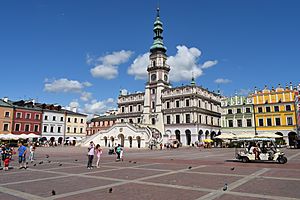
Tourism in Poland has grown a lot since it joined the European Union in 2004. In 2019, nearly 21 million international visitors came to Poland. Tourism is a big part of the country's economy.
Poland has many different attractions. You can find mountains in the south and sandy beaches in the north. The country also has buildings from almost every architectural style.
The most visited city is Kraków. It used to be the capital of Poland. It shows the beauty of the Polish Golden Age and the Renaissance. Many Polish kings were crowned at Wawel in Kraków.
Other famous places include Wrocław, one of Poland's oldest cities. It is known for its dwarf statues and a large market square. The capital, Warsaw, and its historic Old Town were rebuilt after being destroyed in wartime.
A special highlight is the 13th-century Wieliczka Salt Mine. It has long tunnels, an underground lake, and chapels carved from rock salt.
Poland offers many outdoor activities. These include skiing, sailing, mountain hiking, and climbing. You can also enjoy agritourism and visiting historical monuments. Popular destinations are the Baltic Sea coast, the Masurian Lake District, and the Tatra Mountains. There are also over 100 castles, many in Lower Silesian Voivodeship. The largest castle in the world by land area is in Malbork.
Transport and Energy in Poland
Poland has good transport systems, including trains, roads, sea shipping, and air travel. As part of the EU's Schengen Area, Poland is an important transport hub in Central Europe. Major European routes, like the E40, pass through Poland.
The country has a good network of highways, including express roads and motorways. In 2022, Poland had over 4,600 km (2,858 mi) of highways. All local and regional roads are being improved.
In 2017, Poland had the third-longest railway track network in the European Union. The Polish State Railways (PKP) is the main train operator. Poland also has several international airports. The largest is Warsaw Chopin Airport.
Seaports are located along Poland's Baltic coast. The Port of Gdańsk is the only port in the Baltic Sea that can handle large ocean vessels.
Poland's electricity mostly comes from fossil fuels, especially coal. Coal mining provides many jobs. Poland is a major European exporter of coal. The country is also the third-largest buyer of Russian oil exports to the EU.
Poland plans to reduce its use of coal by 25% by 2030. This plan includes building new nuclear power plants and improving energy efficiency. The goal is to reduce greenhouse gas emissions and ensure long-term energy security.
Science and Technology in Poland
Polish people have made many important contributions to science, technology, and mathematics throughout history. One of the most famous is Nicolaus Copernicus (Mikołaj Kopernik). He changed how people understood the universe by showing that the Sun, not the Earth, is at the center. He also developed a theory about money, making him a pioneer in economics.

Poland's universities and research institutes employ many researchers. In the 19th and 20th centuries, many Polish scientists worked abroad. One famous example is Maria Skłodowska-Curie, a physicist and chemist who lived in France. She was the first person to win two Nobel Prizes.
In the early 20th century, Poland was a strong center for mathematics. Famous Polish mathematicians formed the Lwów School of Mathematics and the Warsaw School of Mathematics. Many mathematicians and scientists left Poland due to historical events. In the 1930s, the cryptologist Marian Rejewski invented the Cryptographic Bomb. This helped the Allies break the Enigma code during World War II.
People and Culture of Poland
Poland has a population of about 38.2 million people. It is the ninth-most populated country in Europe. About 60% of Poles live in cities, and 40% live in rural areas. The most populated city is the capital, Warsaw, with 1.8 million people.
In the 2011 Polish census, most people identified as Polish. Smaller groups identified as Silesian, Kashubian, and German. Many Ukrainian citizens also work legally in Poland.
Languages Spoken in Poland
Polish is the official language of Poland and one of the official languages of the European Union. Most people in Poland speak Polish as their first language. There are also 15 minority languages recognized in Poland. One of these is Kashubian, spoken by about 100,000 people daily in northern Poland.
Some towns also use secondary administrative languages. This means you might see bilingual signs there. In 2015, about 32% of Polish citizens said they knew English.
Religion in Poland
Most Polish citizens (87.6%) belong to the Roman Catholic Church. Poland is one of the most religious countries in Europe. Pope John Paul II, who was born in Poland, is highly respected. Many people go on pilgrimages to the Jasna Góra Monastery, a shrine to the Black Madonna.
Freedom of religion is protected by the Constitution. Historically, Poland was known for its religious tolerance. It offered safety to people escaping religious persecution. Poland also had Europe's largest Jewish community until the Holocaust.
Today, religious minorities include Orthodox Christians, Protestants, Jehovah's Witnesses, Eastern Catholics, Jews, and Muslims.
Education System in Poland
The Jagiellonian University, founded in 1364 in Kraków, was the first university in Poland. It is one of the oldest universities still running today. Poland's Commission of National Education, created in 1773, was the world's largest first state ministry of education.
Education in Poland is managed by the Ministry of Education and Science. Kindergarten is optional for children aged three to five. One year of kindergarten is required for six-year-olds. Primary school usually starts at age seven and lasts for eight grades.
After primary school, students can choose different paths. They can go to a four-year high school (liceum), a five-year technical school (technikum), or vocational studies. To go to university, students must pass a maturity exit exam (matura).
Poland has over 500 universities and higher education institutions. Some of the most famous are the University of Warsaw, Warsaw Polytechnic, and Jagiellonian University. Polish students often perform better academically than students in many other countries.
Polish Culture and Traditions
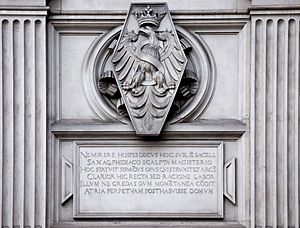
Polish culture is deeply connected to its 1,000-year history. It is an important part of Western civilization. Poles are very proud of their national identity, often linked to the colors white and red. National symbols, especially the crowned white-tailed eagle, are seen everywhere.
Important architectural sites are protected by the National Heritage Board of Poland. Over 100 of Poland's most significant historical places are on the Historic Monuments Register. Another 17 are recognized by UNESCO as World Heritage Sites.
Holidays and Customs in Poland
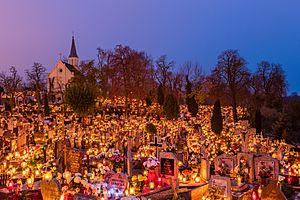
Poland has 13 public holidays each year. These include New Year (January 1), Three Kings' Day (January 6), Easter Sunday and Easter Monday, Labour Day (May 1), Constitution Day (May 3), Pentecost, Corpus Christi, Feast of the Assumption (August 15), All Saints' Day (November 1), Independence Day (November 11), and Christmas (December 25 and 26).
Some Polish traditions are unique. Christmas Eve (Wigilia) is not a public holiday, but it's a very special day. Christmas trees are decorated on December 24. Hay is placed under the tablecloth to remember Jesus' manger. Christmas wafers (opłatek) are shared. A twelve-dish meatless supper is served when the first star appears. An empty plate is left for an unexpected guest.
A popular doughnut and sweet pastry feast happens on Fat Thursday, before Easter. For Holy Sunday, eggs are painted and put in decorated baskets. These baskets are blessed in churches on Easter Saturday. Easter Monday is celebrated with dyngus water fights. On All Saints' Day, families visit cemeteries to clean tombstones and light candles for the deceased.
Music and Art in Poland
Poland has a vibrant music scene with famous musicians like Frédéric Chopin, Artur Rubinstein, and Krzysztof Penderecki. Polish music also has its own genres, like sung poetry and disco polo.
The earliest Polish music dates back to the 13th century. In the 17th and 18th centuries, Polish composers wrote liturgical music and other pieces. By the late 18th century, Polish classical music developed national forms like the polonaise.
Today, jazz and metal music are very popular in Poland. Polish jazz musicians like Krzysztof Komeda created a unique style. Poland also hosts major music festivals, such as the Open'er Festival and Opole Festival.
Polish art has always reflected European trends. Polish painting often focuses on folklore, Catholic themes, history, and realism. It also includes impressionism and romanticism. An important art movement was Young Poland in the late 19th century.
One of the most famous paintings in Poland is Lady with an Ermine (1490) by Leonardo da Vinci. It is displayed in the Czartoryski Museum in Kraków.
Famous Polish artists include Jan Matejko (history painting), Jacek Malczewski (symbolism), and Tamara de Lempicka (art deco). Poland has also produced important avant-garde and contemporary artists.
Polish Architecture Styles
The architecture of Poland shows many European architectural styles. It has strong influences from Italy, Germany, and the Low Countries. Polish towns often grew around central marketplaces. These were surrounded by streets forming an old town.
Poland's traditional landscape features beautiful churches, city buildings, and town halls. Cloth hall markets were once common. The southern mountains are known for their unique Zakopane chalet style.
The earliest architectural style was Romanesque (around the 11th century). Later, brick Gothic (around the 13th century) became very popular. You can see this in castles like Malbork and cathedrals like Kraków. The Renaissance (16th century) brought Italian-style courtyards and palaces. Later styles included Baroque and Neoclassical.
Traditional Polish buildings often used timber or red brick. Old manor houses (dworek), farmsteads, and granaries can still be seen. However, modern building methods became more common in the 20th century.
Polish Literature and Authors
Polish literary works often focus on themes like patriotism, spirituality, and moral stories. The earliest Polish writings, in Latin, date back to the 12th century. The first Polish phrase was recorded in the Book of Henryków.
Poets like Jan Kochanowski and Nicholas Rey were the first to write in Polish during the Renaissance. In the Baroque era, Jesuit philosophy influenced writers. During the Enlightenment, Ignacy Krasicki wrote the first Polish-language novel.
Poland's leading 19th-century romantic poets were the Three Bards. These included Adam Mickiewicz, whose epic poem Pan Tadeusz (1834) is a national classic. In the 20th century, Joseph Conrad became a famous novelist with books like Heart of Darkness.
Modern Polish literature is very diverse. Its fantasy genre is especially popular. Solaris by Stanisław Lem and The Witcher series by Andrzej Sapkowski are famous worldwide. Poland has six Nobel-Prize winning authors, including Henryk Sienkiewicz and Olga Tokarczuk.
Delicious Polish Cuisine
Polish food is a mix of different styles and shares similarities with other regional cuisines. Some popular dishes include pierogi (filled dumplings), kielbasa (sausage), bigos (hunter's stew), and żurek (soured rye soup). Bagels actually started in Poland!
Traditional Polish dishes are hearty. They often use pork, potatoes, eggs, cream, mushrooms, and herbs. Polish food is known for its different kinds of kluski (soft dumplings), soups, and various breads. Common salads include mizeria (cucumber salad) and coleslaw. Meals often end with a dessert like sernik (cheesecake) or makowiec (poppy seed roll).
Traditional alcoholic drinks include honey mead, beer, wine, and vodka. The first mention of vodka in writing came from Poland. Today, beer and wine are the most popular alcoholic drinks. Tea and coffee are also widely enjoyed.
Fashion and Design from Poland

Polish designers have made important contributions to beauty and cosmetics. Helena Rubinstein and Maksymilian Faktorowicz (who created Max Factor) are famous examples. Faktorowicz even came up with the term "make-up." Poland has one of the largest cosmetic markets in Europe.
Historically, fashion was very important in Poland. The country developed its own style called Sarmatism in the 17th century. Polish clothing styles even influenced French fashion, like the robe à la polonaise dress.
Polish Cinema and Films
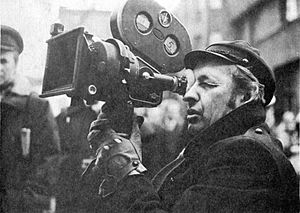
The history of cinema of Poland began in 1894. That's when Kazimierz Prószyński invented the Pleograph, an early film camera. Jan Szczepanik later built the Telectroscope, a prototype for television. Both are seen as pioneers in filmmaking.
Poland has produced many influential directors, producers, and actors. Many of them worked in Hollywood. Famous names include Roman Polański, Andrzej Wajda, and the Warner brothers.
Polish films often explore themes like history, drama, war, and culture. In the 21st century, two Polish films won Academy Awards: The Pianist (2002) and Ida (2013).
Popular Sports in Poland
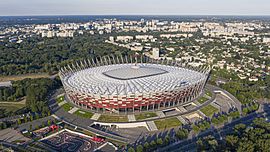
Motorcycle Speedway, volleyball, and association football (soccer) are among the most popular sports in Poland. The country has a rich history of success in international competitions. Other popular sports include track and field, basketball, handball, and ski jumping.
The "golden era" of football in Poland was in the 1970s and early 1980s. The Polish national football team finished third in the 1974 and 1982 FIFA World Cups. They also won a gold medal in football at the 1972 Summer Olympics. In 2012, Poland co-hosted the UEFA European Football Championship.
As of January 2023, the Polish men's national volleyball team is ranked first in the world. They won a gold medal at the 1976 Summer Olympics and several FIVB World Championships.
Mariusz Pudzianowski is a very successful strongman competitor. He has won more World's Strongest Man titles than anyone else.
Poland is also known for motorcycle speedway racing. The top league, Ekstraliga, has very high attendance. The national speedway team is one of the best in the world.
In the 21st century, tennis has become more popular. Poland has produced successful tennis players like World No. 1 Iga Świątek and former World No. 2 Agnieszka Radwanska.
Poles have also achieved a lot in mountaineering, especially in the Himalayas. Polish mountains are a big tourist attraction. Hiking, climbing, skiing, and mountain biking bring many visitors. Water sports like fishing, canoeing, and sailing are popular in the northern regions.
Images for kids
See also
 In Spanish: Polonia para niños
In Spanish: Polonia para niños




